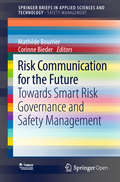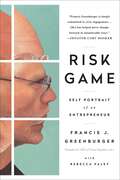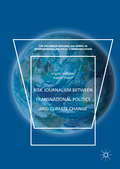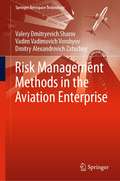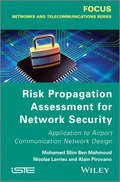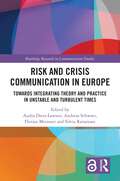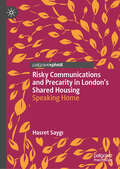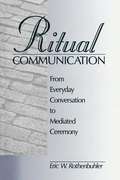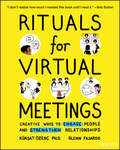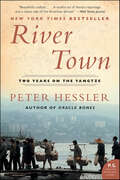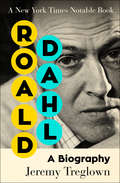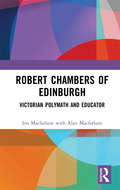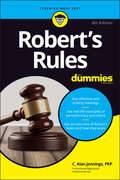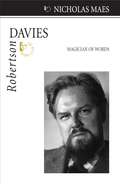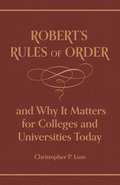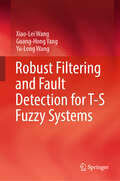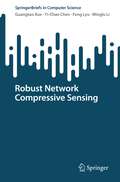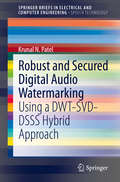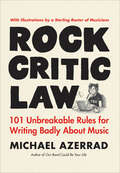- Table View
- List View
Risk Communication for the Future: Towards Smart Risk Governance and Safety Management (SpringerBriefs in Applied Sciences and Technology)
by Mathilde Bourrier Corinne BiederThe conventional approach to risk communication, based on a centralized and controlled model, has led to blatant failures in the management of recent safety related events. In parallel, several cases have proved that actors not thought of as risk governance or safety management contributors may play a positive role regarding safety. Building on these two observations and bridging the gap between risk communication and safety practices leads to a new, more societal perspective on risk communication, that allows for smart risk governance and safety management. This book is Open Access under a CC-BY licence.
Risk Communication: A Handbook for Communicating Environmental, Safety, and Health Risks
by Regina E. Lundgren Andrea H. McMakinThe essential handbook for effectively communicating environmental, safety, and health risks, fully revised and updated Now in its sixth edition, Risk Communication has proven to be a valuable resource for environmental, safety, and health professionals who are tasked with the responsibility of understanding how to apply the most current approaches to communicating risk and debunking misinformation. The sixth edition updates the text with fresh and illustrative examples, lessons learned, and recent research as well as provides advice and guidelines for communicating risk information. The authors include background information to understand the basic theories and practices of risk communication and explain how to plan an effective strategy and put it into action. The book also contains data on evaluating risk communication efforts and explores how to communicate risk during and after a health or environmental emergency. Risk Communication brings together in one resource proven scientific research with practical, hands-on guidance from risk practitioners with over 30 years of experience in the field. This important guide: Provides new examples of communication plans in government and industry, the depiction of probability, methods of working with news media, and use of social media Contains a new chapter on partnerships which covers topics such as assigning roles and expectations, ending partnerships, and more Includes information on Americans with Disability Act laws, particularly Sections 504 and 508 that deal with electronic tools Presents real-world case studies with key lessons all risk communicators can apply. Written for engineers, scientists, professors and students, land use planners, public health practitioners, communication specialists, consultants, and regulators, the revised sixth edition of Risk Communication is the must-have guide for professionals who communicate risks.
Risk Game: Self Portrait of an Entrepreneur
by Francis J. GreenburgerPrior to the real-estate boom of the 1980s, Francis J. Greenburger risked it all to buy three older loft buildings at 50 West Street near the current 9/11 Memorial. He ultimately dreamed of one day erecting a magnificent skyscraper in their place. But disaster struck in 2008, just as his plans were coming together, and development came to a screeching halt. The global financial crisis had made the land practically worthless and it would be years before he could get back on track, but he refused to give up on his dream. Today, 50 West is a striking 780-foot skyscraper with curved glass windows that has become an iconic feature on the city skyline—but it took much more than a financial investment to get there. It required Greenburger to do what he does best—take huge risks at every turn. During his parallel careers, Francis J. Greenburger has made publishing and real-estate history. Whether risking the reputation of his agency for the super -star authors of tomorrow, such as James Patterson to Dan Brown, or pioneering the New York co-op market by taking "hopeless" properties and turning them into prized homes, he has successfully navigated the worlds of business, politics, and social change to become the quintessential American entrepreneur. A math and business prodigy who started working for his father at the age of 12. After a stop–and-start academic career, he voluntarily left one of the most elite and academically distinguished New York City high schools and started his adult life at 15. Greenburger has made it his life's work to find value where others never thought to look, and his keen instincts and innovative strategies have taken him from a high-school "dropout" to a well-educated self-made billionaire. Francis has mastered the "risk game." Now, with Rebecca Paley's gripping prose, he takes us behind the scenes in Risk Game and reveals firsthand how he has become a self-made force in the competitive world of New York real estate—and a champion for nonprofit organizations in the fields of art, education, and, most recently, social and criminal justice.
Risk Journalism between Transnational Politics and Climate Change (The\palgrave Macmillan Series In International Political Communication Ser.)
by Ingrid Volkmer Kasim SharifThis book introduces a new methodology to assess the way in which journalists today operate within a new sphere of communicative ‘public’ interdependence across global digital communities by focusing on climate change debates. The authors propose a framework of ‘cosmopolitan loops,’ which addresses three major transformations in journalistic practice: the availability of ‘fluid’ webs of data which situate journalistic practice in a transnational arena; the increased involvement of journalists from developing countries in a transnationally interdependent sphere; and the increased awareness of a larger interconnected globalized ‘risk’ dimension of even local issues which shapes a new sphere of news ‘horizons.’ The authors draw on interviews with journalists to demonstrate that the construction of climate change ‘issues’ is increasingly situated in an emerging dimension of journalistic interconnectivity with climate actors across local, global and digital arenas and through physical and digital spaces of flows.
Risk Management Methods in the Aviation Enterprise (Springer Aerospace Technology)
by Dmitry Alexandrovich Zatuchny Valery Dmitryevich Sharov Vadim Vadimovich VorobyovThis book provides a comprehensive content for professionals engaged in the development of flight safety regulatory framework, as well as in the design and operation of ground-based or on-board flight support radio electronic systems. It presents mathematical tools and methods of probabilistic theory, mathematical statistics and graph theory, along with some provisions of decision-making theory and multi-criteria analysis. This book helps as a good guide for those involved in aviation risk assessment and air traffic management.
Risk Propagation Assessment for Network Security: Application to Airport Communication Network Design
by Nicolas Larrieu Alain Pirovano Mohamed Slim Ben MahmoudThe focus of this book is risk assessment methodologies for network architecture design. The main goal is to present and illustrate an innovative risk propagation-based quantitative assessment tool. This original approach aims to help network designers and security administrators to design and build more robust and secure network topologies. As an implementation case study, the authors consider an aeronautical network based on AeroMACS (Aeronautical Mobile Airport Communications System) technology. AeroMACS has been identified as the wireless access network for airport surface communications that will soon be deployed in European and American airports mainly for communications between aircraft and airlines. It is based on the IEEE 802.16-2009 standard, also known as WiMAX.The book begins with an introduction to the information system security risk management process, before moving on to present the different risk management methodologies that can be currently used (quantitative and qualitative). In the third part of the book, the authors’ original quantitative network risk assessment model based on risk propagation is introduced. Finally, a network case study of the future airport AeroMACS system is presented. This example illustrates how the authors’ quantitative risk assessment proposal can provide help to network security designers for the decision-making process and how the security of the entire network may thus be improved. Contents Part 1. Network Security Risk Assessment1. Introduction to Information System Security Risk Management Process.2. System Security Risk Management Background.3. A Quantitative Network Risk Management Methodology Based on Risk Propagation.Part 2. Application to Airport Communication Network Design4. The AeroMACS Communication System in the SESAR Project.5. Aeronautical Network Case Study.
Risk and Crisis Communication in Europe: Towards Integrating Theory and Practice in Unstable and Turbulent Times (Routledge Research in Communication Studies)
by Audra Diers-Lawson Andreas Schwarz Florian Meissner Silvia RavazzaniThis timely volume offers an international and cross-disciplinary examination of risk and crisis communication theory and practice in Europe.Placing the rapidly developing field of risk and crisis communication within the context of a Europe in flux – experiencing the amplification of the refugee crisis, Brexit, increasing terrorist attacks, a heightened awareness of the climate crisis, and the COVID-19 pandemic – a cross-continental team of experts explore these developments from a theoretical and practical standpoint. Drawing connections between culture, digital technology, identity, public health, politics, and industry, the analysis offers a multitude of perspectives from across the continent and provides ways ahead for the field of risk and crisis communication.This exciting and innovative volume will interest scholars and students of risk and crisis communication, media studies, political communication, public relations, political studies, and international relations.Chapter 5 of this book is freely available as a downloadable Open Access PDF at http://www.taylorfrancis.com under a Creative Commons [Attribution-Non Commercial-No Derivatives (CC-BY-NC-ND)] 4.0 license
Risk and Health Communication in an Evolving Media Environment
by H Dan O'HairBroadcast media has a particular fascination with stories that involve risk and health crisis events-disease outbreaks, terrorist acts, and natural disasters-contexts where risk and health communication play a critical role. An evolving media landscape introduces both challenges and opportunities for using communication to manage extreme events and hazardous contexts. Risk and Health Communication in an Evolving Media Environment addresses issues of risk and health communication with a collection of chapters that reflect state-of-the-art discussion by top scholars in the field. The authors in this volume develop unique and insightful perspectives by employing the best available research on topics such as brand awareness in healthcare communication, occupational safety, climate change communication, local broadcasts of weather emergencies, terrorism, and the Ebola outbreak, among many other areas. It features analysis of new and traditional media that connects disasters, crises, risks, and public policy issues into a coherent fabric. This book bridges a substantial, but sometimes disconnected body of literature, and by doing so asks how contexts related to risk and health communication are best approached, how researchers balance scientific findings with cultural issues, and how scholars study an increasingly media-savvy society with traditional research methods.
Risky Business: Why Leaders Must Develop a Disruptive Mindset
by Linda HenmanTo position an organization for growth, you cannot shy away from disruptive, high-stakes, pivotal decisions about the future. So why DO you? Why do so many smart leaders cringe when they face disruption? Most people think of disruption as negative while some leaders make disruption their goal. Organizational Psychologist Dr. Linda Henman considers both approaches preventable and costly mistakes. The surprising truth about improving anything you do—personally, professionally, publicly, or privately—lies at the intersection of your ability to think abstractly and your willingness to take prudent risks. Drawing on a rich trove of original, cutting-edge research and four decades’ worth of consulting, Henman knows what it takes to succeed in the C-suite. She dispels myths by presenting a clear and compelling summary of what she has observed—and in many cases, helped to create. Her in-the-trenches experiences spurred her to arrive at this conclusion: Myths about leadership have blinded us to what leaders really do. Many leaders believe in the concept of creative disruption but remain skeptical about trusting it. Jam-packed with big ideas, Risky Business arrives just in time—a rare book that will transform the way you think about risk, change the way you view disruption, and help you understand what you must do to think strategically, to grow dramatically, and to do it quickly. Inspiring and revelatory, filled with story-driven narratives and practical takeaways, Risky Business brings together decades of counterintuitive research to shed light on how you can effect change.
Risky Communications and Precarity in London's Shared Housing: Speaking Home
by Hasret SaygıThis book examines the experiences of single professionals living in shared housing in London, focusing on how language, communication, and social inequalities shape these living arrangements. It frames shared housing not only as an economic condition but also as a communicative, social, and identity-laden experience. Drawing on the discourse analysis of interviews conducted with London&’s millennials sharing a house with strangers, the book introduces a language socialisation framework to illustrate how they learn to become competent housemates. It explores how individuals internalise unspoken norms, manage routines, and negotiate relationships within multilingual, multicultural households. The book also highlights what it means to be single and living in London today, particularly in the context of housing. It examines how house sharers navigate spatial and social boundaries and experience precarity, especially through the lenses of migration, ethnicity, and linguistic background. This book will appeal to scholars in sociolinguistics, anthropology, urban studies, human geography, and architecture.
Ritual Communication: From Everyday Conversation to Mediated Ceremony
by Eric W. RothenbuhlerCombines bibliographic essay and theory construction to provide a unique perspective on ritual as a special and powerful form of communication. Part I is a critical review of definitions of ritual from anthropology, sociology, communication studies, and other literature, ending with an essay on the contributions of communication theory to understanding ritual. Part II is a critical review of the uses of the term ritual in communication studies literature.
Rituals for Virtual Meetings: Creative Ways to Engage People and Strengthen Relationships
by Kursat Ozenc Glenn FajardoDo your virtual meetings feel like a drag? Learn how to use rituals to build trust, increase engagement, and spark creativity. We rely on virtual meetings now more than ever. However, they can often feel awkward, monotonous, and frustrating. If you’re not thrilled with your virtual meetings, rituals can help your group break through to better results by providing structures that unlock freedom. With rituals, virtual meetings can be moments that are elevated and nurtured, opportunities for people to build connection and trust while accomplishing a common goal. In Rituals for Virtual Meetings: Creative Ways to Engage People and Strengthen Relationships authors Kursat Ozenc and Glenn Fajardo show leaders, managers, and meeting organizers how to build rapport and rhythm amongst team members when everyone is not in the same physical space. Rituals for Virtual Meetings provides readers with practical, concrete steps to improve group cohesion and performance, including: How to make virtual meetings more fluid and less awkward How to reduce Zoom fatigue and sustain people’s energy during meetings How to facilitate better interactions with project partners, customers, and clients How community leaders can engage members in a virtual setting How teachers can engage students in virtual classrooms Perfect for anyone who needs to engage people in virtual settings, the book also belongs on the shelves of anyone interested in how to increase team engagement in a variety of contexts.
River Town: Two Years on the Yangtze
by Peter HesslerA New York Times Notable book, this memoir by a journalist who lived in a small city in China is “a vivid and touching tribute to a place and its people” (Kirkus Reviews, starred review). In the heart of China's Sichuan province, amid the terraced hills of the Yangtze River valley, lies the remote town of Fuling. Like many other small cities in this ever-evolving country, Fuling is heading down a new path of change and growth, which came into remarkably sharp focus when Peter Hessler arrived as a Peace Corps volunteer, marking the first time in more than half a century that the city had an American resident. Hessler taught English and American literature at the local college, but it was his students who taught him about the complex processes of understanding that take place when one is immersed in a radically different society.Poignant, thoughtful, funny, and enormously compelling, River Town is an unforgettable portrait of a city that is seeking to understand both what it was and what it someday will be.“This touching memoir of an American dropped into the center of China transcends the boundaries of the travel genre and will appeal to anyone wanting to learn more about the heart and soul of the Chinese people. Highly recommended.” —Library Journal“This is a colorful memoir from a Peace Corps volunteer who came away with more understanding of the Chinese than any foreign traveler has a right to expect.” —Booklist
Roald Dahl: A Biography
by Jeremy TreglownA New York Times Notable Book: A revealing look at the famous twentieth-century children&’s author who brought us The BFG and Charlie and the Chocolate Factory. Few writers have had the enduring cultural influence of Roald Dahl, who inspired generations of loyal readers. Acclaimed biographer Jeremy Treglown cuts no corners in humanizing this longstanding immortal of juvenile fiction. Roald Dahl explores this master of children&’s literature from childhood—focusing a tight lens on the relationship between Dahl and his mother, who lovingly referred to him as &“Apple&”—through to his death. Treglown deftly navigates Dahl&’s time as a fighter pilot in the Royal Air Force, exploring how the experience transformed many of the beliefs that influenced the English writer&’s work, including The Gremlins, which was commissioned by Walt Disney. A former editor of the Times Literary Supplement, Treglown discusses many of Dahl&’s most famous works, such as James and the Giant Peach and Fantastic Mr. Fox, while also delving into his marriage to actress Patricia Neal, combing through letters and archives to show a man who could be both comic and vitriolic, thoughtful yet manipulative and irascible. Treglown highlights many of Dahl&’s literary achievements as well as his breakdowns and shortcomings, presenting a very personal and telling picture of the author and the inner turmoil that crippled him. Separating the man from the myth, Treglown&’s frank, intimate portrait of Dahl illuminates the contradictions within the mind of this beloved author, a man who could be both a monster and a hero. It is required reading for book lovers and film buffs alike.
Robert Chambers of Edinburgh: Victorian Polymath and Educator
by Iris MacfarlaneThis is a book on the life and times of Robert Chambers, founder of W. & R. Chambers publishers. Although there are now books based on some of his letters and on the impact of one of his books, The Vestiges of Natural Creation, there are no books on the whole man and his life. Written by Iris Macfarlane with Alan Macfarlane, the book weaves together three strands. At one level, it is a biography of Chambers and his family; the portrait of a rise from absolute poverty to great wealth and influence. At the second it provides the context of his life by the way of a portrait of nineteenth century Edinburgh as seen through his eyes. At the third it explores the intellectual and organisational revolutions embodied in his life, the explorations in history, folklore, geology, publishing, education and many other fields which made him one of the most exciting thinkers of his age. It is based on extensive archival research among the Chambers’ archives in Edinburgh and conversations with his descendants.Please note: This title is co-published with Social Science Press, New Delhi. Taylor & Francis does not sell or distribute the Hardback in India, Pakistan, Nepal, Bhutan, Bangladesh and Sri Lanka.
Robert's Rules For Dummies
by C. Alan JenningsAll in favor of improving meeting procedures, say Aye! Trying to keep your in-person and virtual meetings on track and running smoothly? You need Robert's Rules of Order! These rules for conducting meetings have stood the test of time as the gold standard for practical and effective procedure in group settings like corporate and nonprofit boards, councils, and more. And there's no better way to learn the latest version of the rules than with Robert's Rules For Dummies. This handy guide demystifies the Rules and offers readers a practical roadmap to applying efficient procedures to everything from conducting online and in-person meetings to voting by email. It also: Contains brand-new, updated content on the latest 12th Edition of Robert’s Rules Offers sample meeting agendas, minutes, scripts, and other material to show you how the pros keep meeting records Walks you through the basic—and not so basic—ways to nominate and elect officers and directors in organizations Ideal for board members, convention delegates, business owners, nonprofit executives, and anyone else trying to maintain an orderly flow of business—online or in person—Robert’s Rules For Dummies is a need-to-read resource that will make you wonder how you ever survived without it.
Robert's Rules of Writing, Second Edition: 111 Unconventional Lessons That Every Writer Needs to Know
by Robert MaselloBestselling author Robert Masello guides working and aspiring writers alike with the hard-won advice, tricks of the trade, and indispensable encouragement that only a seasoned professional can provide.Although there&’s no shortage of books on writing and publishing, there&’s none quite like Robert&’s Rules of Writing: 111 Unconventional Lessons Every Writer Needs to Know. Drawing on his many years of experience as an award-winning journalist, TV writer, and the author of over twenty books published by mainstream houses and translated, to date, into nineteen languages, Robert Masello addresses all the issues that confront, and all the problems that beset, writers of all stripes.Whether you&’re working on a novel or a script, a memoir or a blog, an epic poem or a newspaper piece, you&’re going to have to find the best way to express yourself clearly, persuasively, and entertainingly. You&’ll have to find your own personal voice (much harder than it sounds) and use that unique voice to convey your story, your thoughts, and your opinions, to the many readers out there that you&’re eager to reach; with complete candor and welcome irreverence, Robert&’s Rules of Writing offers the inside knowledge that will help you do just that. As provocative as they are amusing, these rules are purposely designed to challenge the old axioms and get you thinking afresh about your work.In well over a hundred short but pithy takes, Masello guides you over hurdles, around obstacles, and through the seemingly insurmountable barriers to completion and ultimately publication—hooray!—of your writing. It&’s a lively, thought-provoking, and often downright funny addition to any veteran, or fledgling, writer&’s shelf.
Robertson Davies: Magician of Words
by Nicholas MaesBorn in Thamesville, Ontario, a student at Queen’s University in Kingston in the 1930’s, and editor and later publisher of the Peterborough Examiner from the 1940s to the mid-1960s, playwright, essayist, critic, professor, and novelist Robertson Davies (1913-1995) was one of Canada’s pre-eminent literary voices for more than a half-century. Davies, with his generous beard and donnish manner, was the very epitome of the "man of letters," a term he abhorred. Best known for his Deptford Trilogy of novels (Fifth Business, The Manticore, World of Wonders), he also wrote two other trilogies (Salterton and Cornish) and was at work on the third volume of another trilogy (Toronto) when he died. With a life as rich in character and colour as that found in his fiction and essays, Davies had a great fondness for magic and myth, both of which are found in abundance in his work, along with a prodigious streak of wry humour.
Robert’s Rules of Order, and Why It Matters for Colleges and Universities Today
by Christopher P. Loss Henry Martyn RobertA critical edition of the book that paved the way for the democratization of American higher educationIf you have ever attended a town meeting or business lunch, or participated in a church group or department meeting, or served on a faculty senate or maybe just watched C-SPAN, then you have likely encountered Robert's Rules of Order. This critical edition of Henry M. Robert's essential guide to parliamentary procedure features the original text from 1876 along with a companion essay by Christopher Loss, who artfully recounts the book's publication and popular reception, and sheds light on its enduring value for one of the most vital bastions of democracy itself—the modern university.Loss deftly explains why Robert's simple, elegant handbook to democratic governance captured the imagination of so many ordinary citizens during the Gilded Age and how it has shaped the development of our colleges and universities ever since. He shows how Robert's rules can help faculty, administrators, and students to solve problems and overcome challenges through collaboration, disciplined thinking, trust in the facts, and honesty and fairness from all sides.At a time when people's faith in democracy and higher education has been shaken to its core, Robert's Rules of Order offers a powerful reminder of the importance of democratic norms and practices in American life and institutions.
Robust Filtering and Fault Detection for T-S Fuzzy Systems
by Xiao-Lei Wang Guang-Hong Yang Yu-Long WangThis book conducts an in-depth research on robust filtering and fault detection for a class of T-S fuzzy systems. On the basis of the existing research on T-S fuzzy theory, robust filtering theory, and fault diagnosis theory, some new and effective technologies are proposed to solve the problems of robust filtering and fault detection for a class T-S fuzzy systems, while overcoming the shortcomings and limitations of the existing solutions. This book introduces new design solutions for a class of T-S fuzzy systems to address the existing problems in the research of robust filtering and fault detection, namely 1) two new filtering methods are explored to obtain better filtering results than the existing approaches; 2) a new event-triggered filtering scheme is proposed for T-S fuzzy systems with bounded disturbances, which realizes that the designed observer gains in the absence of event-triggered mechanisms are also applicable to the case with event-triggered mechanisms; 3) two new methods are constructed to deal with the asynchronous problems of premise variables effectively, which overcome the defects and limitations of the existing ones; and 4) an effective fault detection scheme for handling measurement outliers is constructed, which can avoid the occurrence of false alarms. This book is intended to inspire researchers and engineers, offering deeper insights into robust filtering and fault detection for T-S fuzzy systems, and equipping them with the latest advancements in fuzzy system theory, robust filtering, and fault diagnosis. It also provides valuable theoretical references for engineers tackling practical engineering problems.
Robust Network Compressive Sensing (SpringerBriefs in Computer Science)
by Minglu Li Feng Lyu Guangtao Xue Yi-Chao ChenThis book investigates compressive sensing techniques to provide a robust and general framework for network data analytics. The goal is to introduce a compressive sensing framework for missing data interpolation, anomaly detection, data segmentation and activity recognition, and to demonstrate its benefits. Chapter 1 introduces compressive sensing, including its definition, limitation, and how it supports different network analysis applications. Chapter 2 demonstrates the feasibility of compressive sensing in network analytics, the authors we apply it to detect anomalies in the customer care call dataset from a Tier 1 ISP in the United States. A regression-based model is applied to find the relationship between calls and events. The authors illustrate that compressive sensing is effective in identifying important factors and can leverage the low-rank structure and temporal stability to improve the detection accuracy. Chapter 3 discusses that there are several challenges in applying compressive sensing to real-world data. Understanding the reasons behind the challenges is important for designing methods and mitigating their impact. The authors analyze a wide range of real-world traces. The analysis demonstrates that there are different factors that contribute to the violation of the low-rank property in real data. In particular, the authors find that (1) noise, errors, and anomalies, and (2) asynchrony in the time and frequency domains lead to network-induced ambiguity and can easily cause low-rank matrices to become higher-ranked. To address the problem of noise, errors and anomalies in Chap. 4, the authors propose a robust compressive sensing technique. It explicitly accounts for anomalies by decomposing real-world data represented in matrix form into a low-rank matrix, a sparse anomaly matrix, an error term and a small noise matrix. Chapter 5 addresses the problem of lack of synchronization, and the authors propose a data-driven synchronization algorithm. It can eliminate misalignment while taking into account the heterogeneity of real-world data in both time and frequency domains. The data-driven synchronization can be applied to any compressive sensing technique and is general to any real-world data. The authors illustrates that the combination of the two techniques can reduce the ranks of real-world data, improve the effectiveness of compressive sensing and have a wide range of applications. The networks are constantly generating a wealth of rich and diverse information. This information creates exciting opportunities for network analysis and provides insight into the complex interactions between network entities. However, network analysis often faces the problems of (1) under-constrained, where there is too little data due to feasibility and cost issues in collecting data, or (2) over-constrained, where there is too much data, so the analysis becomes unscalable. Compressive sensing is an effective technique to solve both problems. It utilizes the underlying data structure for analysis. Specifically, to solve the under-constrained problem, compressive sensing technologies can be applied to reconstruct the missing elements or predict the future data. Also, to solve the over-constraint problem, compressive sensing technologies can be applied to identify significant elementsTo support compressive sensing in network data analysis, a robust and general framework is needed to support diverse applications. Yet this can be challenging for real-world data where noise, anomalies and lack of synchronization are common. First, the number of unknowns for network analysis can be much larger than the number of measurements. For example, traffic engineering requires knowing the complete traffic matrix between all source and destination pairs, in order to properly configure traffic and avoid congestion. However, measuring the flow between all source and destination pairs is very expensive or even infeasible. Reconstructing data from a small number of measurements is an underconstrained proble
Robust and Secured Digital Audio Watermarking: Using a DWT-SVD-DSSS Hybrid Approach (SpringerBriefs in Speech Technology)
by Krunal N. PatelThis book discusses digital audio watermarking copyright assurance. The author first outlines the topic of watermarking data that can be used for copyright assurance that incorporates text messages, copyright audio, handwritten text, logo and cell phone numbers. The objective of this book is to propose a new algorithm that can embed and extract the watermarking information. The execution of the newly proposed algorithm is surveyed by testing data utilizing a group of various audio file types and against various attacks. The book also presents a new digital watermark algorithm that preserves the copyright property of the audio files. To do this, the author uses two techniques -- DWT and SVD -- with the combination of other techniques (DFT and DSSS) to enhance security and also provide high robustness and imperceptibility against various malicious attacks.
Rock Critic Law: 101 Unbreakable Rules for Writing Badly About Music
by Michael AzerradStraight out of his beloved Twitter feed @RockCriticLaw, acclaimed rock journalist and author of the classic books Come As You Are: The Story of Nirvana and Our Band Could Be Your Life, Michael Azerrad turns his trenchant eye to the art of rock writing itself, hilariously skewering 101 of the genre’s seemingly endless litany of hackneyed phrases and tropes.One of the finest music writers today, Michael Azerrad has catalogued the shortcuts, lazy metaphors and uninspired prose that so many of his beloved colleagues all too regularly rely on to fill column inches. In 2014, he began his wickedly droll Twitter feed @RockCriticLaw to expose and make fun of this word-hash. Now, he consolidates these "Laws" into one witty, comprehensive and fully illustrated volume.Rock Critic Law includes timeless gems such as:If a band pioneered something, you must say they are "seminal." That is the Seminal Law of Rock Criticism.If a recording features densely layered guitars, then you MUST use the phrase "sonic cathedrals."Even when it’s easy to find out with research, by all means ask a band how they got their name.Please feel free to deny an artist’s individuality and say they are "the new [x]."If two guitars play a melodic line in harmony, you MUST say they are "twin lead guitars."All 101 Rock Critic Laws are accompanied by original illustrations from Ed Fotheringham, beloved Seattle scenester and highly regarded artist who has created album covers for everyone from, well, seminal grunge band Mudhoney to iconic jazz label Verve Records, as well as illustrations for TheAtlantic, Vanity Fair, The New Yorker and more, making this book a must-have for music lovers everywhere. A unique appreciation of music writing from one of its own, Rock Critic Law irreverently captures all the passion and furor of fandom.
Rock Your Presentation: A New Guide to Speaking with Passion
by Nigel BarlowThis book will protect your audiences from the following disorders:· Death by PowerPoint· Tedium· Compulsive fidgeting· Losing-the-Will-to-Live SyndromeNearly all of us have to pitch or present our ideas, whether in a formal setting like a theatre, at a company conference, in a classroom or even selling a concept one-to-one to our boss. In Rock your Presentation, Nigel Barlow, a professional keynote speaker and creative coach to many of the world's most famous organisations, gives you inspiring insights and practical techniques to 'rock up' your presentation or speech. Many of these tips come from exploring what makes great music so moving and impactful, and are easy to apply to make your own talks more dynamic and memorable. Try changing your key for different emotional impact; come up with a stronger chorus and an exciting climax; create your speaker's rider; be a protest singer to unleash your passion; and learn when and how to go unplugged to touch your audience. Whether you want to create a whole new presentation or tune up a tired old one, Rock Your Presentation will give you plenty of fresh ideas.
Rock Your Presentation: A New Guide to Speaking with Passion
by Nigel BarlowNearly all of us have to pitch or present our ideas, whether in a formal setting after lunch to a hundred jaded salespeople, in a lecture theatre or classroom, putting over our thoughts to a team of colleagues, or even selling a concept one-on-one to your boss.In all these situations we can choose between delivering a message that sounds like muzak, or one that wakes the listener up. Most presentations and pitches could benefit from being 'rocked up' - becoming more dynamic and memorable, in ways that arouse the passion of the audience. By applying the ideas in ROCK YOUR PRESENTATION you can deliver better, livelier and more emotionally engaging talks which leave audiences with the kind of high you get from being in a crowd at a great concert.Barlow applies the rock'n'roll metaphor throughout the book, turning what, to many, is a stressful subject into an exciting and fun exercise you can't wait to try out. So take the Van Halen approach to planning your presentation, deliver it like a hit song with a chorus and a bridge, play a few well-rehearsed power chords and set your audience ablaze.
